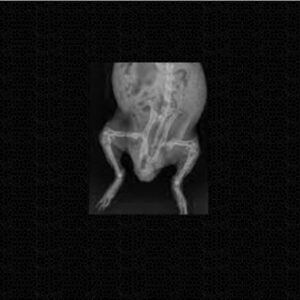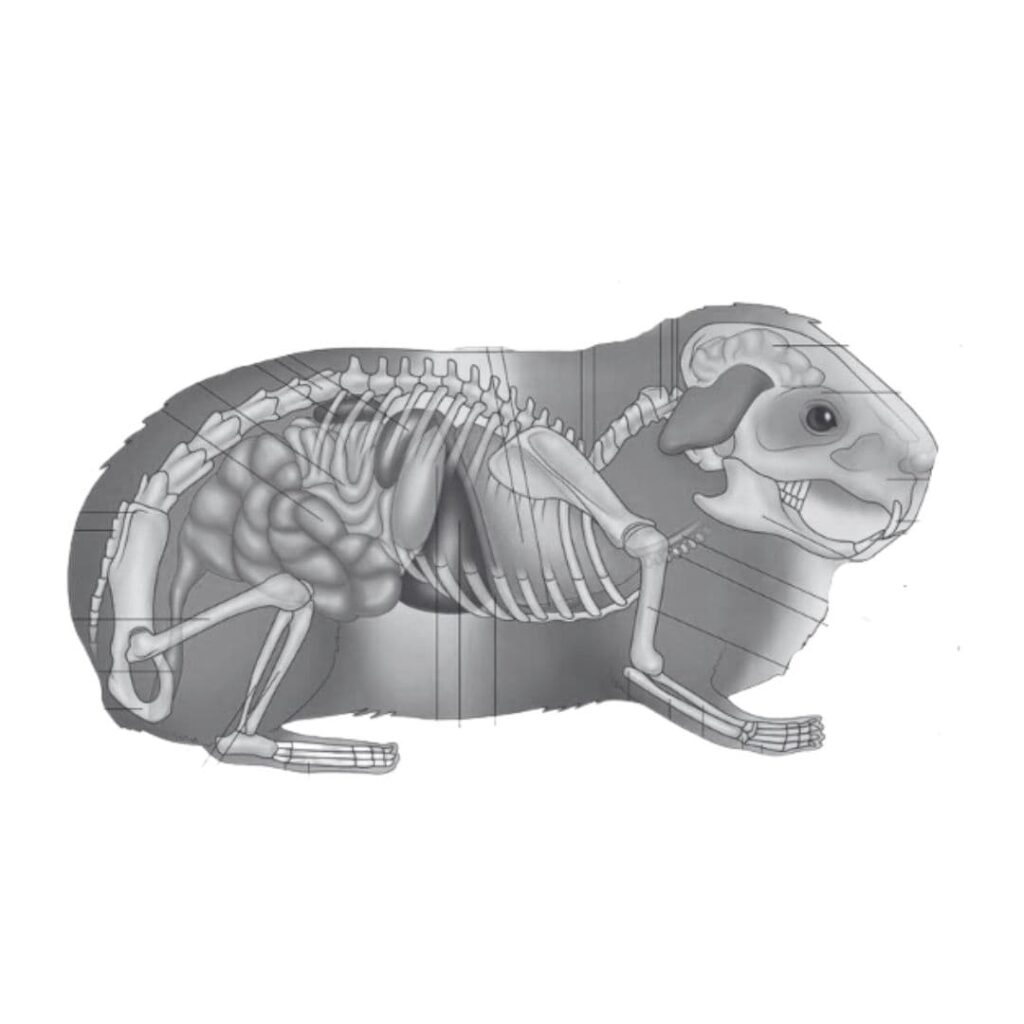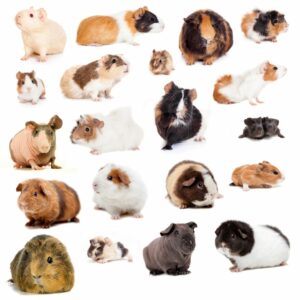One of the most common questions asked by new and potential guinea pig owners is whether or not these adorable rodents have tails. The answer is a bit complicated, but don’t worry – we’ve got you covered.
Table of Contents
Guinea Pigs and Tails: A Tale of Two Tales

Guinea pigs do have tails, but their tails are not visible to the naked eye. This is because their tails are vestigial, meaning they are reduced in size and have no external function. This is due to their evolutionary history. Guinea pigs’ ancestors lived in an environment where they didn’t need to climb, so their tails lost their purpose over time.
Guinea pigs are thought to have evolved from wild cavies, small rodents living in the Andes Mountains of South America. Wild cavies have tails, but they are much shorter than the tails of rats and mice. It is thought that guinea pigs may have lost their tails over time due to evolutionary pressure.
One possibility is that shorter tails were an advantage for guinea pigs living in the Andes Mountains. Long tails can get caught on branches and other obstacles, which could make it difficult for guinea pigs to escape predators. Additionally, long tails can be a target for predators, so guinea pigs with shorter tails may have been more likely to survive and reproduce.
Another possibility is that guinea pigs lost their tails due to environmental changes. For example, if guinea pigs began to live in burrows, they may not have needed tails for balance or steering. Over time, the genes for tail development may have been lost through natural selection.
What Do Guinea Pigs Use Instead of Tails?
Guinea pigs have many other adaptations that help them to balance and move without tails. For example, they have strong hind legs for jumping and hopping.
They also have a wide stance that helps them to stay stable. Additionally, guinea pigs are very agile and can turn quickly, even without the help of a tail.
Do Guinea Pigs Have Tailbones?
Even though guinea pigs do not have visible tails, they have a few tailbones. These tailbones are located at the end of the spine and fused together. The tailbones are thought to be remnants of guinea pigs’ ancestral tails.
The Illusion of a Tail
Some long-haired guinea pigs, such as Peruvians and Lankaryas, may give the illusion of having a tail due to rosettes and cowlicks in their fur. However, these formations are purely cosmetic and have no connection to the tail bones.
Pro Tip: Regular brushing can help keep these cowlicks under control and maintain your guinea pig’s distinguished, tailless look. If you’re looking for a guinea pig breed known for lacking a tail, you can also consider hairless breeds.
Do Guinea Pigs Have Tail Bones?
Yes, guinea pigs do have tail bones. However, their tails are very small and fused to their pelvis, so they are not visible externally. The guinea pig’s tail bones are called coccygeal vertebrae, and there are typically seven of them. These fused vertebrae are located at the very base of the spine, just above the rump.
The Anatomy of a Guinea Pig’s Tail

A guinea pig’s vestigial tail is made up of vertebral bones, which are part of the spinal cord. They have approximately 32 to 36 bones, including the vestigial tail with a set of tailbones known as caudal or coccygeal vertebrae.
A guinea pig’s entire vertebrae column consists of the following sets of bones:
4-6 caudal (coccygeal) vertebrae
7 cervical vertebrae
13-14 thoracic vertebrae
6 lumbar vertebrae
2-3 sacral vertebrae
A Guinea Pig’s Skeletal Structure
Guinea pigs have a fascinating musculoskeletal structure containing 258 bones, including three primary parts:
The Axial: Consists of the skull, hyoid apparatus, vertebrae (individual bones that make the spine), ribs, and sternum.
The Appendicular: Consists of the pectoral and pelvic girdles and pectoral and pelvic limbs.
The Heterotrophic: Consists of multiple sesamoid bones.
How to Hold a Guinea Pig Safely?
While they may not have their rodent cousins’ long, swishing tails, their delicate spines and tailbones require gentle handling to prevent injuries.
Rough handling, whether through sudden grabs or improper lifting techniques, can cause significant stress and discomfort in guinea pigs. In their efforts to escape, they may struggle and twist, potentially leading to spinal injuries, including damage to the tailbones. These injuries can manifest as pain, mobility issues, and even paralysis.
To ensure the safety and well-being of your guinea pig, prioritize a gentle and cautious approach when handling them. Avoid picking up your new guinea pig immediately upon bringing them home. Allow them time to acclimate to their new environment and familiarize themselves with your presence. Once they are comfortable eating from your hand and welcoming your gentle touch, you can gradually introduce lifting them.
When the time comes to pick up your guinea pig, adopt the ‘scoop’ technique. Place one hand under their chest, supporting the front end of their body, while using the other hand to cup their bottom. This two-handed approach ensures stability and prevents any undue pressure on their delicate spine.
Key Points to Remember
Guinea pigs, despite their lack of external tails, have a spinal cord with tailbones that are susceptible to injury.
Rough handling can cause stress and discomfort in guinea pigs, potentially leading to spinal injuries.
Allow your new guinea pig time to acclimate to their new environment before handling them.
Vet Q&A
What should I do if I see something wrong with my guinea pig’s tail?
If you notice anything unusual about your guinea pig’s tail, such as redness, swelling, or discharge, take it to the veterinarian right away. These symptoms could be a sign of an infection or other health problem.
Can guinea pigs grow new tails?
No, adult guinea pigs cannot grow new tails. This is because their tail bones are fused to their spines and cannot regenerate.
Guinea pig tails are not essential for their survival, so they have not evolved the ability to grow them back.
If a guinea pig’s tail is injured or amputated, it will not grow back. Instead, the guinea pig will develop a scar at the site of the injury
Are guinea pigs tails sensitive?
Yes, guinea pigs’ tails are sensitive. The tail bones are embedded in muscle tissue, and the skin on the tail is thin and delicate. This makes the tail an important sensory organ for guinea pigs.
Guinea pigs use their tails to communicate with each other, and they can feel vibrations and touch through their tails. They can also use their tails to balance and for proprioception, which is the sense of where their bodies are in space.
If you touch a guinea pig’s tail gently, it will likely twitch or wiggle. This is because the guinea pig is feeling the touch through its tail. If you touch the tail too forcefully or suddenly, the guinea pig may flinch or even squeak in pain.
It is important to handle guinea pigs gently and avoid touching their tails too much. If you need to pick up a guinea pig, always support it under its chest and hindquarters. Avoid picking it up by its tail, as this can cause pain and injury.
Can guinea pigs control their tails?
Guinea pigs have limited control over their tails. They cannot move their tails independently of their bodies, and they cannot use them to grip objects or manipulate their environment. However, they can use their tails for balance and communication.
Guinea pigs can also use their tails to express their emotions. For example, a guinea pig may hold its tail high and straight when it is feeling excited or happy, and it may curl its tail under its body when it is feeling scared or stressed.
Although guinea pigs have limited control over their tails, they are still important sensory organs that help the animals to navigate their environment and communicate with each other
Why do some guinea pigs have more visible tails than others?
The visibility of a guinea pig’s tail can vary depending on several factors, including:
Genetics: Tail length and visibility are influenced by a guinea pig’s genetic makeup. Some breeds, like Abyssinian and Peruvian guinea pigs, tend to have slightly longer tail bones that may be more visible, especially if their fur is shorter or thinner.
Fur type: Long-haired guinea pigs, such as Peruvians and Shelties, may have fur that grows over their tail stub, making it less noticeable. Rough-coated guinea pigs may have cowlicks or whorls in their fur that can create the illusion of a longer tail.
Body condition: Overweight or obese guinea pigs may have more fat deposits around their tail area, making the tail stub appear more prominent. However, this isn’t a good thing for a guinea pig. Pay extra attention to their nutrition to prevent health complications from obesity.
Positioning: The position of a guinea pig’s body can also affect the visibility of its tail. When a guinea pig is relaxed and stretched out, its tail may be more visible than when it is curled up or hunched over.
Tail bone length: Even among guinea pigs of the same breed and fur type, there can be some variation in the length of the tail bones. Some individuals may have slightly longer tail bones than others, making their tail stubs more apparent.
My Senior Paws is a participant in the Amazon Services LLC Associates Program, an affiliate advertising program designed to provide a means for sites to earn advertising fees by advertising and linking to Amazon.com. We also participate in other affiliate programs which compensate us for referring traffic.




